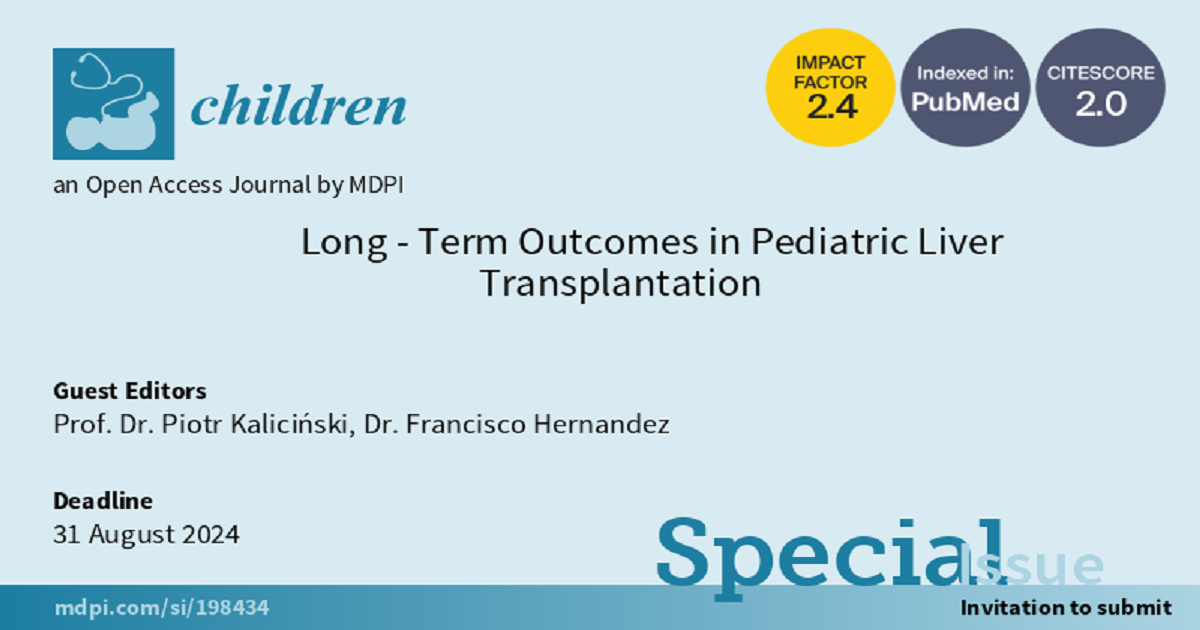- 2.1Impact Factor
- 3.8CiteScore
- 16 daysTime to First Decision
Long-Term Outcomes in Pediatric Liver Transplantation
This special issue belongs to the section “Pediatric Surgery“.
Special Issue Information
Dear Colleagues,
Liver transplantation in children has become a routine treatment for a wide spectrum of diseases leading to acute or chronic liver failure and/or the damage of other organs and systems.
There are multiple problems associated with liver transplantation in children: surgical, immunological, complications and co-morbidities, intensive care, infectious, ethical, psychological, and other. All of them are of great importance in achieving progress and better long-term results after liver transplantation in pediatric patients.
We are preparing this Special Issue on “Long-Term Outcomes in Pediatric Liver Transplantation” and invite contributions from researchers and clinicians affiliated to pediatric liver transplantation centers—members of TransplantChild, a European Reference Network with the main goal of having a significant impact on children’s quality of life in the long term. One of the ways to achieve this is to promote research, innovation, and expertise in the field of transplantation. Authors from other centers are also invited to contribute to this Special Issue.
Prof. Dr. Piotr Kaliciński
Dr. Francisco Hernandez
Guest Editors
Manuscript Submission Information
Manuscripts should be submitted online at www.mdpi.com by registering and logging in to this website. Once you are registered, click here to go to the submission form. Manuscripts can be submitted until the deadline. All submissions that pass pre-check are peer-reviewed. Accepted papers will be published continuously in the journal (as soon as accepted) and will be listed together on the special issue website. Research articles, review articles as well as short communications are invited. For planned papers, a title and short abstract (about 250 words) can be sent to the Editorial Office for assessment.
Submitted manuscripts should not have been published previously, nor be under consideration for publication elsewhere (except conference proceedings papers). All manuscripts are thoroughly refereed through a single-blind peer-review process. A guide for authors and other relevant information for submission of manuscripts is available on the Instructions for Authors page. Children is an international peer-reviewed open access monthly journal published by MDPI.
Please visit the Instructions for Authors page before submitting a manuscript. The Article Processing Charge (APC) for publication in this open access journal is 2400 CHF (Swiss Francs). Submitted papers should be well formatted and use good English. Authors may use MDPI's English editing service prior to publication or during author revisions.
Keywords
- liver transplantation
- long-term outcomes after liver transplantation
- transplantation for hepatobiliary tumors in children
- quality of life after liver transplantation
- long-term problems and complications

Benefits of Publishing in a Special Issue
- Ease of navigation: Grouping papers by topic helps scholars navigate broad scope journals more efficiently.
- Greater discoverability: Special Issues support the reach and impact of scientific research. Articles in Special Issues are more discoverable and cited more frequently.
- Expansion of research network: Special Issues facilitate connections among authors, fostering scientific collaborations.
- External promotion: Articles in Special Issues are often promoted through the journal's social media, increasing their visibility.
- e-Book format: Special Issues with more than 10 articles can be published as dedicated e-books, ensuring wide and rapid dissemination.

